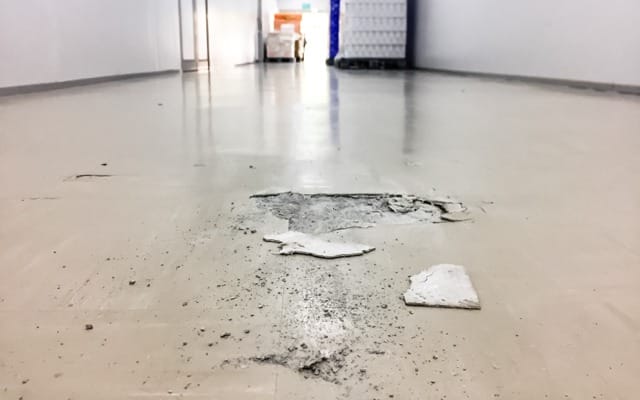Cracks, sunken areas, the dreaded spalling—no contractor likes to see these things when they walk onto a job site. Unfortunately, improper curing processes, moisture issues, and other exterior forces can result in concrete damage to warehouse floors and corporate offices alike. If you’ve been tasked with polishing a concrete floor and arrive to find the site severely damaged, your job just got that much harder. But evaluating a concrete surface before attempting to polish it is essential to ensuring the integrity of the end result.
What about these various factors causes damaged concrete, and how can you make sure you’re starting off with a surface ready for polishing? Runyon Surface Prep has you covered with both the tools and knowledge you need to execute flawless projects from start to finish. Read on for a closer look at some common causes of concrete damage.
What Leads to Damaged Concrete?
1. Corrosion
Reinforced concrete flooring offers a high level of structural stability—but the steel bars embedded in the floor can cause their own problems. While concrete typically provides a layer of protection that keeps the steel from rusting, chloride ions from substances like deicing salts can penetrate through cracks and pores. When the steel corrodes as a result, the surrounding concrete can experience both cracking and spalling. Corrosion is one of the biggest causes of concrete deterioration, so it’s essential that reinforced concrete be installed and maintained correctly to minimize the risk of damage.
2. Freeze-Thaw Cycle
If your concrete floor is located outdoors, it’s exposed to the elements constantly. That means rain, wind, and the endless freeze-thaw cycle, to name just a few natural forces. Like corrosion, moisture is another primary culprit of concrete damage. When excess moisture in your concrete freezes, it expands, putting pressure on cavities within the material. With enough time and pressure, those cavities will rupture. Continued freeze-thaw cycles will slowly break down your concrete, leaving you with a cracking, scaling surface. Fortunately, concrete with a lower permeability (i.e., a low ratio of water to cement) holds up much better under freeze-thaw conditions.
3. Fire
Fire and other sources of intense heat can damage concrete beyond repair. While the material itself won’t actually burn, flames can still affect the structural integrity of concrete, ruining its elasticity and both flexural and compressive strength. You might even see concrete spalling as a result of moisture that turned into water vapor when heated.
4. Improper Installation
Improperly constructed joints, excessive moisture during curing or in the mix, and premature sealing are just a few potential examples of an installation gone wrong. If the contractor installing the concrete flooring was in a rush to complete the job, you’ll likely find crazing, spalling, blisters, and other signs of damage that require fixing before you can get to polishing.
Protecting Concrete From Damage
Prevention and proactive maintenance are crucial to keeping your concrete floors from being damaged in the first place. Proper installation of concrete is essential, and a high-quality polish job on top of that will also go a long way in protecting surfaces from damage and deterioration. If you’re installing a cement topping, for example, be sure that the substrate is clean and free of oil, sealers, hardeners, curing compounds, and any other substances that could inhibit adhesion and weaken your installation. Prep the surface, whether by shot blasting or grinding, and be sure that you’ve achieved the ideal concrete profile before continuing.
Above all, you should always inspect the existing concrete floor before starting to polish. Information about the age and quality of the floor can help you determine whether or not it can be safely polished, or whether new material is needed. If there are significant foundational issues, the entire floor will need to be replaced before you can get going. But if you find minimal damage, you may be able to proceed by simply filling in small cracks and reinforcing joints with a joint filler.
Runyon offers a number of excellent joint fillers made by Metzger. We also keep an extensive stock of concrete mixes, repair materials, chemicals, and other surface preparation materials on hand to ensure that you have everything you need to get your concrete flooring ready for its transformation.
Once polished, you or your customer will be able to enjoy durable, high-shine flooring with minimal maintenance for years to come—but remember to watch out for cosmetic dangers like oil spills and adhesive residue!
Concrete Spalling
If you’re wondering how to repair spalling concrete, it might not be as difficult as you think. Instead of an entirely new floor, you may just need to resurface the existing one. Mild damage may be fixed by simply removing the damaged layer of concrete and pouring a new one—just be sure to power wash and potentially scarify the surface first.
Tackle Any Project With Runyon Surface Prep
Whether you’re evaluating damage to an existing floor or working to polish a newly installed concrete surface, Runyon Surface Prep has the tools, machinery, and technical knowledge you need to handle concrete polishing and surface preparation with confidence. Reach out today to learn more about how our facility can equip you for just about any job.
